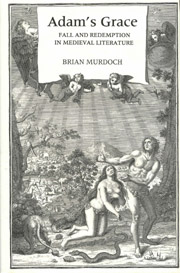Book contents
- Frontmatter
- Contents
- Ursula
- Preface
- Dedication
- Introduction: Interpreting Adam
- One After Eden: the Apocryphal Adam
- Two Written in Tablets of Stone: Adam and Gregorius
- Three Stultus et Insipiens: Adam, Parzival and the Knowledge of God
- Four Innocent Blood: Redemption and the Leper
- Five Promises to Adam: the Fall, the Redemption and Medieval Drama
- Six By the Scriptures Alone? Playing Adam in the Reformation and Beyond
- Bibliography
- Biblical Index
- General Index
One - After Eden: the Apocryphal Adam
Published online by Cambridge University Press: 12 September 2012
- Frontmatter
- Contents
- Ursula
- Preface
- Dedication
- Introduction: Interpreting Adam
- One After Eden: the Apocryphal Adam
- Two Written in Tablets of Stone: Adam and Gregorius
- Three Stultus et Insipiens: Adam, Parzival and the Knowledge of God
- Four Innocent Blood: Redemption and the Leper
- Five Promises to Adam: the Fall, the Redemption and Medieval Drama
- Six By the Scriptures Alone? Playing Adam in the Reformation and Beyond
- Bibliography
- Biblical Index
- General Index
Summary
WE MAY BEGIN with three quite separate problems associated with the reflection in medieval European literature of the Fall and the Redemption, both of which are based on literary constructs, the brief narrative of Adam and Eve at the beginning of Genesis, and the rather longer Gospel narrative. The first problem is a simple one: the story of Adam and Eve is too short, a remarkably slender basis on which to place Paul's anthropology, Irenaeus's theory of recapitulation, and the entire doctrine of original sin. The second problem is both a logical and a literary one: Adam was created pure but lost his original innocence, and this innocence is inconceivable for us, as Adam's supposed descendants, precisely because we do not have that innocence. Put succinctly, fallen mankind cannot imagine what it is like to be naked and unashamed, and this leads to logical impasses for theological and secular literary writers alike. And in any case – and this is the third problem – it is not always easy to distinguish between theological and secular literature, as T. S. Eliot, David Cecil, C. S. Lewis, Helen Gardner and others have found, the last-named devoting the 1966 Ewing Lectures to that question and reaching a very open-ended conclusion. There is a difference of putative audience and authorial intent, admittedly, between Hrabanus Maurus's Commentaria in Genesim and – let us say – Henry de Vere Stacpoole's The Blue Lagoon, insofar as the latter is indirect, intended as entertainment, and incidentally mildly erotic, whilst Hrabanus's work is direct, intended as instruction, and can be, incidentally, mildly soporific.
- Type
- Chapter
- Information
- Adam's GraceFall and Redemption in Medieval Literature, pp. 21 - 49Publisher: Boydell & BrewerPrint publication year: 2000



